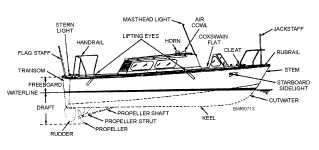BOAT SAFETY
Because the majority of Navy personnel are con-
cerned with small boats only in the role of passengers,
this section is written from the standpoint of
passengers, rather than crew members. Every Sailor
should be familiar with the following boat safety
precautions:
Obey all orders from the coxswain and boat
officer.
Embark in a quiet, orderly manner and move as
far forward as possible. Once embarked, stay in
place. Keep all parts of your body in the boat; do
not perch on the gunwales.
Don’t engage in horseplay.
Never needlessly distract the attention of crew
members from their duties.
Don’t sit on life jackets—to do so mats the filler
and reduces buoyancy.
When told to do so, don your life jacket
immediately.
Don’t smoke in a boat.
During heavy weather, boat loads must be
reduced.
If told not to embark or requested to disembark,
do so without argument
If a boat swamps or capsizes, don’t panic. Fear is
transmitted easily from person to person, and a
terrified individual drowns easily. Never strike
out alone.
Never strike out alone. Stay with the boat or
huddle with other passengers because a large
group can be found much more easily than
individual swimmers.
BOAT TERMS AND NOMENCLATURE
Boat crew members often develop the habit of
calling objects and the activities around them by their
proper names. In times of emergency, your
understanding and correct response to such terms could
save valuable time.
Abaft. Any part of the boat aft of amidships.
After end (aft). The after end (aft) of a boat is the stern.
Amidships. Amidships is a point about halfway between
the bow and stern and the sides of the boat.
Athwartships. When something is said to be
athwartships, it’s across the boat from side to side.
Forward end (fore). The forward end (fore) of the boat is
the bow.
Inboard. Inboard usually describes the area inside the
boat or an object nearer the centerline of the boat.
Outboard. Outboard describes the area furthermost from
the boat’s centerline or beyond the side of a boat.
Starboard. When facing forward of the boat, your
right-hand side is the starboard.
Port. When you are facing forward of the boat, your
left-hand side is the port.
Figure 7-13 shows a 26-foot personnel boat with
features that are similar to most Navy boats.
By studying the nomenclature shown in
figure 7-13, you will become familiar with much of the
deck and hull equipment used on Navy boats. The
glossary in appendix I of this training material will help
you identify some of the terms.
7-7
Student Notes:
Figure 7-13.—Boat nomenclature.

